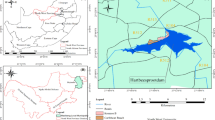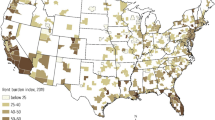Abstract
This article seeks to evaluate indicators of overcrowding and housing affordability used by Eurostat and to propose alternatives that may better reflect the specific contexts of individual EU states while preserving the possibility of valuable international comparison. The alternatives are assessed on the basis of the distance between the results produced by objective measures and the subjective evaluations of the problem reported by households, using one and the same data source: EU-SILC. The results show that alternative threshold definitions may decrease the current discrepancy between subjective perceptions and objective indicators of housing affordability and overcrowding. They also have the potential to lead to more effective targeting of public subsidies so that they are directed towards housing programmes that not only have an objective goal but also a subjectively identified legitimacy.




Similar content being viewed by others
Notes
We used the following datasets: EUSILC UDB 2005—version 5 of August 2009, EUSILC UDB 2007—version 5 of March 2011, EUSILC UDB 2009—version 6 of March 2014 and EUSILC UDB 2011—version 4 of August 2014. The EU-SILC datasets were made available on the basis of contract no. EU-SILC/2007/16 between the European Commission, Eurostat, and the Institute of Sociology, Czech Academy of Sciences.
‘Net of housing allowance’ means that the amount of housing allowance is deducted from both housing cost and disposable household income.
According to the description of EU-SILC variables the housing allowances are included in total housing cost of homeowners only since 2010. For the preceding years reported in following analysis were therefore housing allowances added to the total housing cost of homeowners, who received housing allowances.
The median rather than the average housing cost ratio was chosen because medians are generally less sensitive to the existence of extreme values. While the median housing cost ratio remained basically unchanged by the methodological adjustment taking households with a negative ratio or a ratio above 100 % into account (see the section devoted to methodology and data), the averages for the housing cost ratio differed significantly before and after the adjustment.
A room is defined as a space in a housing unit that is at least 4 square metres in size, and includes normal bedrooms, dining rooms, living rooms and habitable cellars and attics with a ceiling height of over 2 metres and accessible from inside the unit. Kitchens are not counted unless the cooking facilities are in a room used for other purposes; only exclude it if the space is used only for cooking. Thus, for example, a kitchen-cum-dining room is included as one room in the count of rooms. The following space does not count as rooms: bathrooms, toilets, corridors, utility rooms and lobbies. Verandas, lounges and conservatories count only if they are used year-round. A room used solely for business use is excluded, but is included if shared between private and business use. If the dwelling is shared by more than one household all rooms are counted as belonging to the owner/tenant except those exclusively used by the other households.
The following countries were excluded from the analysis: Bulgaria (the median housing cost ratio in 2007 was nine percentages point above the ratio in 2009 and the share of households with ratio above the 40 % threshold was almost three times higher in 2007 than in 2009), Germany (the median ratio in 2007 and 2009 was approximately five percentage points higher than in 2005 and 2011, and the share of household with ratio above the 40 % threshold was more 10 percentage points higher in the same years), Croatia (joined the survey in 2011, so nothing can be inferred about the volatility of its ratio), Lithuania (the median ratio in 2007 and 2009 was approximately five percentage points lower in 2005 and 2009 than in the other years, and the same applied for the share of households with ratio above the 40 % threshold, Norway (the median ratio in 2005 was half what it was in the years after that), Romania (the median ratio in 2011 was less than half what it was in 2007 and 2009) and Slovakia (in 2007 the median ratio was seven percentage points higher than in 2011).
Correlation is significant at the 0.05 level (2-tailed).
Correlation is significant at the 0.01 level (2-tailed).
The correlation between the share of households that feel their housing costs to be a heavy burden and income quintile ratio was somewhat weaker (0.40), but still significant at the 0.05 level. The correlation between the share of households that feel their housing costs to be a heavy burden and coefficient of variation in incomes was close to zero (0.032) and thus it was not statistically significant.
References
Abeysinghe, T., & Gu, J. (2011). Lifetime income and housing affordability in Singapore. Urban Studies, 48(9), 1875–1891.
Alesina, A., Di Tella, R., & MacCulloch, R. (2004). Inequality and happiness: Are Europeans and Americans different? Journal of Public Economics, 88(9–10), 2009–2042.
Allardt, E. (1976). Dimensions of welfare in a comparative Scandinavian study. Acta Sociologica, 19(3), 227–239.
Chasco, C., & Le Gallo, J. (2012). The impact of objective and subjective measures of air quality and noise on house prices: A multilevel approach for downtown Madrid. Economic Geography, 89(2), 127–148.
Dewilde, C., & De Decker, P. (2014). Trends in housing inequalities in Europe: What has happened and why does it matter? HOWCOME Working Paper 4.
Di Tella, R., MacCulloch, R., & Oswald, A. (2003). The macroeconomics of happiness. The Review of Economics and Statistics, 85(4), 809–827.
Easterlin, R. (1995). Will raising the incomes of all increase the happiness of all? Journal of Economic Behavior & Organization, 27(1), 35–47.
Eurostat. (2014a). Statistics explained (http://ec.europa.eu/eurostat/statistics-explained/). Accessed on 21.12.2014. http://ec.europa.eu/eurostat/statistics-explained/index.php/Glossary:Housing_cost_overburden_rate.
Eurostat. (2014b). Statistics explained (http://ec.europa.eu/eurostat/statistics-explained/). Accessed on 21.12.2014. http://ec.europa.eu/eurostat/statistics-explained/index.php/Glossary:Overcrowding_rate.
Gan, Q., & Hill, R. J. (2009). Measuring housing affordability: Looking beyond the median. Journal of Housing Economics, 18, 115–125.
Garnett, D. (2000). Housing finance. Coventry: Chartered Institute of Housing.
Haffner, M., & Heylen, K. (2011). User costs and housing expenses. Towards a more comprehensive approach to affordability. Housing Studies, 26(4), 593–614.
Hayo, B., & Seifert, W. (2003). Subjective economic well-being in Eastern Europe. Journal of Economic Psychology, 24, 329–348.
Helliwell, J. (2003). How’s life? Combining individual and national variables to explain subjective well-being. Economic Modelling, 20(2), 331–360.
Iacovou, M., & Skew, A. (2011). Household composition across the new Europe: Where do the new Member States fit in? Demographic Research, 25(14), 465–490.
Kahneman, D., & Krueger, A. (2006). Developments in the measurement of subjective well-being. Journal of Economic Perspectives, 20(1), 3–24.
Lee, T., & Marans, W. (1978). Objective and subjective indicators: Effects of scale discordance on interrelationships. Social Indicators Research, 8, 47–64.
Lewis, S., & Lyo, L. (1986). The quality of community and the quality of life. Sociological Spectrum, 6, 397–410.
Li, J. (2014). Recent trends on housing affordability research: Where we are up to? Urban Research Group—CityU on Cities Working Paper Series, No. 5/2014. https://www.google.cz/url?sa=t&rct=j&q=&esrc=s&source=web&cd=3&ved=0CDUQFjACahUKEwjq9fD8mo3IAhXLWSwKHXQWD8g&url=http%3A%2F%2Fwww.cityu.edu.hk%2Fcityuoncities%2Fupload%2Ffile%2Foriginal%2F705520150126143516.pdf&usg=AFQjCNFV557DWBQul8EM-FbHV9mlmYo43Q&cad=rja.
Liao, Pei-shan. (2009). Parallels between objective indicators and subjective perceptions of quality of life: A study of metropolitan and county areas in Taiwan. Social Indicators Research, 91(1), 99–114.
Lux, M., & Sunega, P. (2006). Vývoj finanční dostupnosti nájemního a vlastnického bydlení v průběhu hospodářské transformace v České republice (1991–2003) (Housing affordability of rental and owner-occupied housing over the course of the economic transformation in the Czech Republic 1991–2003). Sociologický časopis/Czech Sociological Review, 42(5), 851–881.
Maclennan, D., & Williams, R. (1990). Affordable housing in Europe. York: Joseph Rowntree Foundation.
OECD. (2013). How’s life? At a glance. In How’s life? 2013: Measuring well-being. OECD Publishing. http://www.keepeek.com/Digital-Asset-Management/oecd/economics/how-s-life-2013/how-s-life-at-a-glance_how_life-2013-6-en#page1.
Özdemir, E., & Ward, T. (2009). Housing and social inclusion. European Commission. http://www.google.cz/url?sa=t&rct=j&q=&esrc=s&source=web&cd=1&cad=rja&uact=8&ved=0CCUQFjAA&url=http%3A%2F%2Fec.europa.eu%2Fsocial%2FBlobServlet%3FdocId%3D4828%26langId%3Den&ei=7OSHVIigBYT1UIe1ghA&usg=AFQjCNFX_YMfxI99p6JXo9Lpnbe7nReIRw&bvm=bv.81456516,d.d24.
Randall, C., Corp, A., & Self, A. (2014). Measuring national well-being: Life in the UK, 2014. Newport: Office for National Statistics. http://www.ons.gov.uk/ons/rel/wellbeing/measuring-national-well-being/life-in-the-uk–2014/art-mnwb–life-in-the-uk–2014.html.
Schuessler, K. F., & Fisher, G. A. (1985). Quality of life research and sociology. Annual Review of Sociology, 11, 129–149.
Stevenson, B., & Wolfers, J. (2008). Economic growth and subjective well-being: Reassessing the Easterlin paradox. NBER Working Paper No. 14282, August 2008. http://www.nber.org/papers/w14282.
Stiglitz, J., Sen, A., & Fitoussi, J. (2009). Report by the commission on the measurement of economic performance and social progress. http://www.stiglitz-sen-fitoussi.fr/documents/rapport_anglais.pdf.
Thalmann, P. (1999). Identifying households which need housing assistance. Urban Studies, 36(11), 1933–1947.
Večerník, J. (2012). Subjektivní indikátory měření blahobytu: přístupy měření a data (Subjective indicators of well-being: Approaches, measurements and data). Politická ekonomie, 3, 291–308.
Acknowledgments
This article has received financial support from the ‘Centre of Excellence’ project entitled ‘The Dynamics of Change in Czech Society’ which is funded by the Czech Science Foundation (Grant Agency of the Czech Republic, GACR, Grant No. 14-36154G).
Author information
Authors and Affiliations
Corresponding author
Rights and permissions
About this article
Cite this article
Sunega, P., Lux, M. Subjective perception versus objective indicators of overcrowding and housing affordability. J Hous and the Built Environ 31, 695–717 (2016). https://doi.org/10.1007/s10901-016-9496-3
Received:
Accepted:
Published:
Issue Date:
DOI: https://doi.org/10.1007/s10901-016-9496-3




